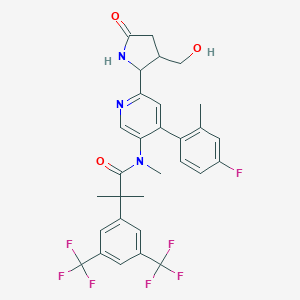

You can:
| Name | CHEMBL1911964 |
|---|---|
| Molecular formula | C30H28F7N3O3 |
| IUPAC name | 2-[3,5-bis(trifluoromethyl)phenyl]-N-[4-(4-fluoro-2-methylphenyl)-6-[3-(hydroxymethyl)-5-oxopyrrolidin-2-yl]pyridin-3-yl]-N,2-dimethylpropanamide |
| Molecular weight | 611.561 |
| Hydrogen bond acceptor | 11 |
| Hydrogen bond donor | 2 |
| XlogP | 5.1 |
| Synonyms | BDBM50419332 SCHEMBL1866905 |
| Inchi Key | AYUYKFLBPMUYIU-UHFFFAOYSA-N |
| Inchi ID | InChI=1S/C30H28F7N3O3/c1-15-7-20(31)5-6-21(15)22-12-23(26-16(14-41)8-25(42)39-26)38-13-24(22)40(4)27(43)28(2,3)17-9-18(29(32,33)34)11-19(10-17)30(35,36)37/h5-7,9-13,16,26,41H,8,14H2,1-4H3,(H,39,42) |
| PubChem CID | 57396275 |
| ChEMBL | CHEMBL1911964 |
| IUPHAR | N/A |
| BindingDB | 50419332 |
| DrugBank | N/A |
Structure |  |
| Lipinski's druglikeness | This ligand has more than 10 hydrogen bond acceptor. This ligand is heavier than 500 daltons. This ligand has a partition coefficient log P greater than 5. |
You can:
| GLASS ID | Name | UniProt | Gene | Species | Length |
|---|---|---|---|---|---|
| 17811 | Neuromedin-K receptor | P29371 | TACR3 | Homo sapiens (Human) | 465 |
| 17810 | Substance-P receptor | P25103 | TACR1 | Homo sapiens (Human) | 407 |
zhanglab![]() zhanggroup.org | +65-6601-1241 | Computing 1, 13 Computing Drive, Singapore 117417
zhanggroup.org | +65-6601-1241 | Computing 1, 13 Computing Drive, Singapore 117417